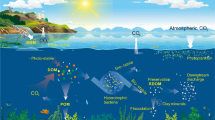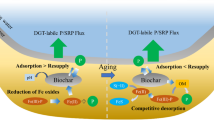Abstract
Sediment pore water concentrations of Fe2+, Mn2+, NH sup+inf4 and CH4 were analyzed from both diver-collected cores and anin situ equilibration device (peeper) in Lake Erie's central basin. Sediment oxygen demand (SOD) was measured at the same station with a hemispheric chamber (including DO probe and recorder) subtending a known area of sediments. The average SOD was 9.4 mM m−2 day−1 (0.3 g m−2 day−1). From pore water gradients within the near-surface zone, the chemical flux across the interface was calculated indirectly using Fick's first law modified for sediments. These calculations, using core and peeper gradients, always showed sediment loss to overlying waters, and variations between the two techniques differed by less than an order of magnitude for Fe2+ and CH4. The transport of these reduced constituents can represent a sizeable oxygen demand, ranging from less than 1% for Fe2+ and Mn2+ to as high as 26% for NH sup+inf4 , and 30% for CH4. The average flux of these constituents could account for about a third of the SOD at the sediment-water interface of this station.
Similar content being viewed by others
References
Berner, R. A., 1980. Early Diagenesis: a Theoretical Approach. Princeton University Press, Princeton, N.J. 241 pp.
Blanton, J. O. & Winklhofer, R. A., 1972. Physical processes affecting the hypolimnion of the central basin of Lake Erie. In: Burns, N. M. & Ross, C. (Eds.) Project Hypo — an Intensive Study of the Lake Erie Central Basin Hypolimnion and Related Surface Water Phenomena, pp. 9–38. U.S.E.P.A. Tech. Report TS-05–71–208–24
Bouldin, D. R., 1968. Models for describing the diffusion of oxygen and other mobile constituents across the mud-water interface. J. Ecol. 56: 77–87.
Bowman, G. T. & Delfino, J. J., 1980. Sediment oxygen demand techniques: A review and comparison of laboratory and in situ systems. Water Res. 14: 491–499.
Burns, N. M. & Ross, C., 1972. Oxygen-nutrient relationships within the Central Basin of Lake Erie. In: Burns, N. M. & Ross, C. (Eds.) Project Hypo — an Intensive Study of the Lake Erie Central Basin Hypolimnion and Related Surface Water Phenomena, pp. 85–119. U.S.E.P.A. Tech. Report TS-05–71–208–24
Cappenberg, T. E., 1974. Interrelations between sulfate-reducing and methane-producing bacteria in bottom deposits of a fresh-water lake. I. Field observations. Antonie van Leeuwenhoek 40: 285–295.
Charlton, M. N., 1980. Hypolimnion oxygen consumption in lakes: discussion of productivity and morphometry effects. Can. J. Fish. aquat. Sci. 37: 1531–1539.
Deis, D. A., 1981. Distribution of dissolved and particulate organic carbon in sediments of Lake Erie and two polluted harbors. M.Sc. thesis, Wright State University, Dayton, OH. 119 pp.
Fendinger, N. J., 1981. Distributions and related fluxes of dissolved pore water gases (CH4, N2, and ΣCO2) in the sediments of Lake Erie and two polluted harbors. M.Sc. thesis, Wright State University, Dayton, OH. 107 pp.
Fendinger, N. J. & Adams, D. D., 1982. A headspace equilibration technique for measurement of dissolved gases in sediment interstitial water. Manuscript, Dept. Chemistry, Wright State University, Dayton, OH. 18 pp.
Hanes, N. B. & Irvine, R. L., 1968. New techniques for measuring oxygen uptake rates of benthal systems. J. Wat. Pollut. Control Fed. 40: 223–232.
Hargrave, B. T., 1973. Coupling carbon flow through some pelagic and benthic communities. J. Fish. Res. Bd Can. 30: 1317–1326.
Hargrave, B. T., 1975. The importance of total and mixed layer depth in the supply of organic material to bottom communities. Symp. Biol. Hung. 15: 157–165.
Hesslein, R. H., 1976. An in situ sampler for close interval pore water studies. Limnol. Oceanogr. 21: 912–914.
Jones, W. J. & Paynter, M. J. B., 1980. Populations of methaneproducing bacteria and in vitro methanogenesis in salt marsh and estuarine sediments. Appl. Environ. Microbiol. 39: 864–871.
Klapwijk, A. & Snodgrass, W. J., 1981. Model for nitrificationdenitrification and oxygen demand in lake sediments. Manuscript, Dept. Chemical Engineering, McMaster University, Hamilton, Ont. 30 pp.
Klapwijk, A. & Snodgrass, W. J., 1982. Experimental measurement of sediment nitrification and denitrification in Hamilton Harbour, Canada. In: Sly, P. G. (Ed.) Proceedings 2nd Int. Sediment Freshwater Interaction Symp., June 1981. Kingston, Ontario (This volume)
Lerman, A., 1979. Geochemical Processes: Water and Sediment Environments. John Wiley, New York. 481 pp.
Li, Y-H. & Gregory, S., 1974. Diffusion of ions in seawater and in deep sea sediments. Geochim. cosmochim. Acta 38: 703–714.
Lucas, A. M. & Thomas, N. A., 1972. Sediment oxygen demand in Lake Erie's Central Basin, 1970. In: Burns, N. M. & Ross, C. (Eds.) Project Hypo — an Intensive Study of the Lake Erie Central Basin Hypolimnion and Related Surface Water Phenomena, pp. 45–50. U.S.E.P.A. Tech. Report TS-05–71208–24
Matisoff, G., Lindsay, A. H., Matis, S. & Sosta, F. M., 1980. Trace metal mineral equilibria in Lake Erie sediments. J. Great Lakes Res. 6: 353–366.
Matisoff, G., Fisher, J. B. & Lick, W. J., 1981. Diagenesis and chemical mass transfer in Lake Erie sediments. Grant No. R-805716020, US EPA, Duluth, David Dolan, Proj. Manager, Grosse Ile, MI. Unpublished report. 149 pp
McAullife, D., 1971. GC determination of solutes by multiple phase equilibration. Chem. Tech. 1971: 46–51.
Murray, J. W. & Grundmanis, V., 1980. Oxygen consumption in pelagic marine sediments. Science 289: 1527–1530.
Naguib, M., 1975. Overall metabolic regulations in cultures of the obligate methane-oxidizing strain M102. In: Microbial growth on C1-compounds, pp. 203–212. Proc. Int. Symp., Tokyo, Japan. Society Fermentation Technology, Osaka, Japan.
Naguib, M., 1976. Stoichiometry of methane oxidation in the methane-oxidizing strain M102 under the influence of various CH4/O2 mixtures. Z. Allg. Mikrobiol. 16: 437–444.
Natrella, M. G., 1966. Experimental Statistics. National Bureau Standards Handbook 91, Superintendent Documents, U.S. Govern. Printing Office, Washington, D.C. 504 pp.
Reeburgh, W. S., 1967. An improved interstial water sampler. Limnol. Oceanogr. 12: 163–165.
Revsbech, N. P., Sørensen, J., Blackburn, T. H. & Lomholt, J. P., 1980. Distribution of oxygen in marine sediments measured with microelectrodes. Limnol. Oceanogr. 25: 403–411.
Revsbech, N. P., Jorgensen, B. B. & Brix, O., 1981. Primary production of microalgae in sediments measured by oxygen microprofile, H14CO −3 fixation, and oxygen exchange methods. Limnol. Oceanogr. 26: 717–730.
Rudd, J. W. M. & Hamilton, R. D., 1978. Methane cycling in a eutrophic shield lake and its effects on whole lake metabolism. Limnol. Oceanogr. 23: 337–348.
Walker, R. R., 1980. Modelling sediment oxygen demand in lakes. M. Sc. thesis, McMaster Univ., Hamilton, Ont. 160 pp.
Wang, W., 1980. Fractionation of sediment oxygen demand. Water Res. 14: 603–612.
Wollast, R. & Garrels, R. M., 1971. Diffusion coefficient of silica in seawater. Nature 229: 94.
Zeikus, J. G. & Winfrey, M. R., 1976. Temperature limitation of methanogenesis in aquatic sediments. Appl. Environ. Microbiol. 31: 99–107.
Author information
Authors and Affiliations
Rights and permissions
About this article
Cite this article
Adams, D.D., Matisoff, G. & Snodgrass, W.J. Flux of reduced chemical constituents (Fe2+, Mn2+, NH sup+inf4 and CH4) and sediment oxygen demand in Lake Erie. Hydrobiologia 91, 405–414 (1982). https://doi.org/10.1007/BF02391956
Issue Date:
DOI: https://doi.org/10.1007/BF02391956




